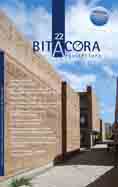Editorial
Contenido principal del artículo
Resumen
Después del número conmemorativo dedicado al centenario de la Universidad Nacional, la revista Bitácora Arquitectura inicia una nueva etapa ampliando su espacio a una variedad de autores y temas que pretenden enriquecer el conocimiento especializado en la arquitectura y el urbanismo.
Como colofón de la celebración universitaria, el maestro Sergio Flores reflexiona sobre los valores y conceptos que sustentan la práctica del urbanismo. Traza una historia de la disciplina en México y destaca la participación de la unam en la enseñanza y formación de profesionales dedicados a la planeación y el diseño urbanos, proceso que culminó con la creación de la licenciatura en urbanismo que acaba de cumplir 25 años.
Arturo Ortiz afirma en su artículo “Espacio, género y sexualidad” que: las expresiones sociales del comportamiento sexual o bien la construcción social del género se manifiestan en la conformación de espacios arquitectónicos y urbanos. A partir del análisis de los trabajos de Leslie Salzinger y Aaron Betsky sugiere propuestas para diseñar espacios flexibles acordes con la diversidad que caracteriza a la sociedad contemporánea.
El uso de la fotografía como documento historiográfico es la temática del artículo firmado por Eulalia Ribera y Fernando Aguayo, quienes presentan los avances de una investigación centrada en la ciudad de Orizaba, uno de los asentamientos pionero en el proceso de la industrialización en México, y testigo de las primeras transformaciones del paisaje urbano asociadas a la modernidad.
También desde la perspectiva histórica, pero en un momento muy distinto, Luis María Calvo realiza un repaso de aquellas fundaciones hispanas en América que fracasaron; ciudades que de-saparecieron por circunstancias particulares y que hoy conocemos mediante documentos y vestigios arqueológicos.
La historia de la calle de Moneda en la Ciudad de México y su arquitectura monumental es revisada por Mónica Cejudo. Se trata de una de las calles más antiguas y emblemáticas del Centro Histórico, en cuyos paramentos se ubican grandes ejemplos de la arquitectura novohispana como la Casa de Moneda o las sedes de la primera imprenta y de la primera universidad de América Latina, entre otros.
Natalia de la Rosa y Daniel Vargas Parra recuperan la historia de un proyecto significativo de la arquitectura moderna en México: el Sanatorio para Tuberculosos de Huipulco (Ciudad de México, 1929), obra del arquitecto José Villagrán García quien con la asesoría del médico Ismael Cosío Villegas logró integrar el conocimiento de vanguardia de ambas disciplinas en un edificio cuyo diseño anticipó los criterios de la bioarquitectura.
Asimismo, en el contexto de la modernidad, José Javier Alayón elabora una comparación, a través de la metáfora del itinerario, de la producción arquitectónica de José Luis Sert y Carlos Raúl Villanueva, representantes destacados del movimiento de la arquitectura moderna en España y Venezuela.
El carácter académico de Bitácora Arquitectura está expresado en esta ocasión por dos artículos. El doctor Alfonso Ramírez Ponce titular de la cátedra extraordinaria “Federico Mariscal”, 2009 relata un taller de mampostería ligera realizado en la Universidad de Cambridge (Reino Unido) en octubre de 2010.
El trabajo de los estudiantes de la Facultad de Arquitectura plasmado en un artículo firmado por Rafael Salinas que describe la evolución de la colonia del Valle, un espacio representativo de la modernidad adoptada por la clase media en la Ciudad de México, cuyo origen se remonta a 1908.
La portada es un reconocimiento a la obra del arquitecto Mauricio Rocha. La Escuela de Artes Plásticas de Oaxaca es un ejemplo citado por Fernando Guerrero en su artículo “Pasado y porvenir de la arquitectura de tapia”, una técnica de construcción tradicional que hace algunos años estaba casi en extinción, y que gracias a la investigación de especialistas comienza a ser revalorada con el auge de la llamada arquitectura ecológica.
Finalmente, como parte de la nueva etapa de la revista, nos complace informar la inminente aparición de la versión digital en el portal de revistas arbitradas de la unam, lo cual permitiré la difusión de los contenidos a un público más amplio.
Detalles del artículo
Citas en Dimensions Service

Bitácora arquitectura by Universidad Nacional Autónoma de México is licensed under a Creative Commons Reconocimiento-NoComercial-SinObraDerivada 4.0 Internacional License.
Creado a partir de la obra en http://arquitectura.unam.mx/bitacora.html.

